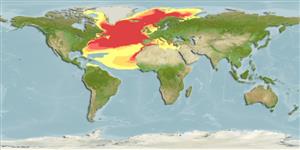Teleostei (teleosts) >
Myctophiformes (Lanternfishes) >
Myctophidae (Lanternfishes) > Myctophinae
Etymology: Benthosema: Greek, benthos = depth of the sea + Greek, sema, sematos = signal, flag (Ref. 45335).
Environment: milieu / climate zone / depth range / distribution range
Ecology
Marine; pelagic-oceanic; non-migratory; depth range 0 - 1407 m (Ref. 58426), usually 300 - 400 m (Ref. 82363). Deep-water; 81°N - 7°N, 81°W - 61°E
Eastern Atlantic: Norway and Greenland south to Morocco, and from Mauritania to Guinea (Mauritanian Upwelling Region). Seasonally present from Morocco to Mauritania along the edge of the continental shelf. Also known from the Mediterranean Sea. Western Atlantic: Baffin Bay to northern edge of Gulf Stream. Northwest Atlantic: Canada (Ref. 5951).
Length at first maturity / Size / Weight / Age
Maturity: Lm 3.6, range 2 - 5.5 cm
Max length : 10.3 cm SL male/unsexed; (Ref. 4479); max. reported age: 8 years (Ref. 35388)
Dorsal spines (total): 0; Dorsal soft rays (total): 13 - 14; Anal soft rays: 17 - 19. Males with single black-bordered supracaudal gland; females with two infra-caudal luminous patches; occasional specimens with both. Luminous organs in the anal area, 5-6 anteriorly and 5-7 posteriorly, 11-13 total.
High-oceanic, mesopelagic at depths between 375-800 m during daytime and 12-200 m during night. Depth range from 0-850 m (Ref. 4479) and from 541-1085 m in the eastern Ionian Sea (Ref. 56504). Photophores present. Feeds mainly on calanoid copepods, also euphausiids and copepodites. Feeding occurs at night in Norwegian fjords (Ref. 9209) and in northwest Africa (Ref. 9194). Mature from about 3 cm onward. Spawning peaks in the Mediterranean in late spring with east-to-west progression. Female produces 160-2,000 eggs depending on her size (Ref. 35388).
Spawns both north and south of the Polar Fronts in the eastern North Atlantic. Reported to perish after spawning (Ref. 9707).
Bauchot, M.-L., 1987. Poissons osseux. p. 891-1421. In W. Fischer, M.L. Bauchot and M. Schneider (eds.) Fiches FAO d'identification pour les besoins de la pêche. (rev. 1). Méditerranée et mer Noire. Zone de pêche 37. Vol. II. Commission des Communautés Européennes and FAO, Rome. (Ref. 3397)
IUCN Red List Status (Ref. 130435: Version 2024-2)
Threat to humans
Harmless
Human uses
Fisheries: of potential interest
Tools
Special reports
Download XML
Internet sources
Estimates based on models
Preferred temperature (Ref.
123201): 1.6 - 12.8, mean 5.1 °C (based on 258 cells).
Phylogenetic diversity index (Ref.
82804): PD
50 = 0.5312 [Uniqueness, from 0.5 = low to 2.0 = high].
Bayesian length-weight: a=0.00871 (0.00704 - 0.01078), b=3.09 (3.03 - 3.15), in cm total length, based on LWR estimates for this species (Ref.
93245).
Trophic level (Ref.
69278): 3.1 ±0.29 se; based on food items.
Resilience (Ref.
120179): Medium, minimum population doubling time 1.4 - 4.4 years (K=0.20-0.45; tm=1-3; tmax=8; Fec=162).
Fishing Vulnerability (Ref.
59153): Low to moderate vulnerability (27 of 100).
Nutrients (Ref.
124155): Calcium = 123 [33, 471] mg/100g; Iron = 1.07 [0.34, 3.69] mg/100g; Protein = 17.1 [14.5, 19.6] %; Omega3 = 1.11 [0.47, 2.67] g/100g; Selenium = 21.5 [5.3, 95.2] μg/100g; VitaminA = 58.7 [7.6, 434.5] μg/100g; Zinc = 0.697 [0.293, 1.744] mg/100g (wet weight);
